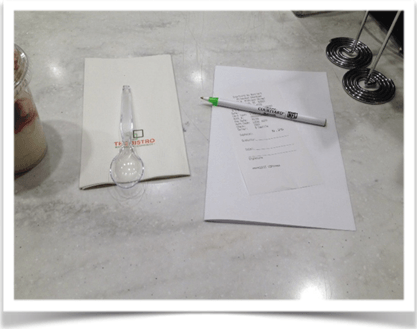[alert type=”general”] This guest post by Paul Mulvey is part of a series of contributions by business analysis professionals I respect, and whose work I follow. Paul is an experienced trainer of business analysts, and a popular guest speaker at IIBA chapter meetings and development days. Paul is co-author of Business Analysis for Dummies. Enjoy! – JB[/alert]
It’s not because they don’t want you to know, it’s because they do things automatically and don’t even think to tell you about it. The best way to truly uncover 100% what they do is to watch them in action. Case in point seen at a Marriott Courtyard during breakfast.
After every sale, the server prints out a receipt and hands it to the customer so they can fill out the room number and sign the receipt. In fact, if you asked them about the process, they would tell you they: take the customer’s order, give them a receipt to sign, gather all the food for their order, and provide the order to the customer. That is their process. But as soon as you start observing them perform their process, it suddenly becomes clear they have not told you everything.
One morning, I notice there is a notepad on the (normally spotlessly clean) Bistro counter. And as I watched the counter people serve those in line before me, I noticed every time they put down a receipt, they would place it on the notepad with a pen, and slide the whole package across the counter for the customer to sign. The eternal BA (is there a copyright on that name?) I am, when it was my turn, and they slid the receipt over with the notepad underneath, I questioned them why they were performing the process in this fashion. There didn’t seem to be anything with the notepad. They responded the ballpoint pens they were assigned do not work when signing the receipts directly on the countertop. The combination of the slippery receipt paper and the super-smooth Corian counter did not provide enough traction for the pen to write. So, by putting the notepad underneath, it provided the ability to write on the receipt.
If you think about it, when you interview stakeholders in business, they will probably tell you their process, but will leave out details they just don’t think about. They will tell you they “give the receipt to the customer to sign” but may leave out the workaround they have developed. This is crucial to understand how you need to get the process completed, because without it, the pen doesn’t write! Only through observing the actions will you pick up these deviations from an assigned process, or can you confirm the description given to you by a stakeholder.
The next time you need to elicit a process, try this: Interview the subject matter expert and document the steps in the process. Then watch them perform the process. Chances are, you will pick up a lot more steps in the process than what they told you. They are not trying to be secretive, they are just being human. They make internal assumptions. By observing the process, you get to see each individual action they perform in order to complete the entire process. Only then can you question the reasons behind certain actions so you can truly understand it.






Hey JB. I really liked your article – it’s a great analogy of how people forget the little details unless they are working the process.
Because it’s the way my mind works – there could be another reason why they ask for you to sign on a pad of paper. Depending on what you’re signing… they could be trying to steal information (such as your signature or credit card info) without having to make a copy at another time. You provide the carbon copy for them imprinted on the pad!
I was once at a bank and was asked to provide my social on a sticky note pad. After writing the number on the top of the pad, I handed the top page to the clerk & kept the rest of the pad for just this reason!
Great comment, Yosef. Thanks! And I’m not surprised in the least that you saw it through the lens of security!
Good informative article. I loved it. Actually content in this article is very clear but i got much more info through Yosef’s comment. Thank you so much both of you.